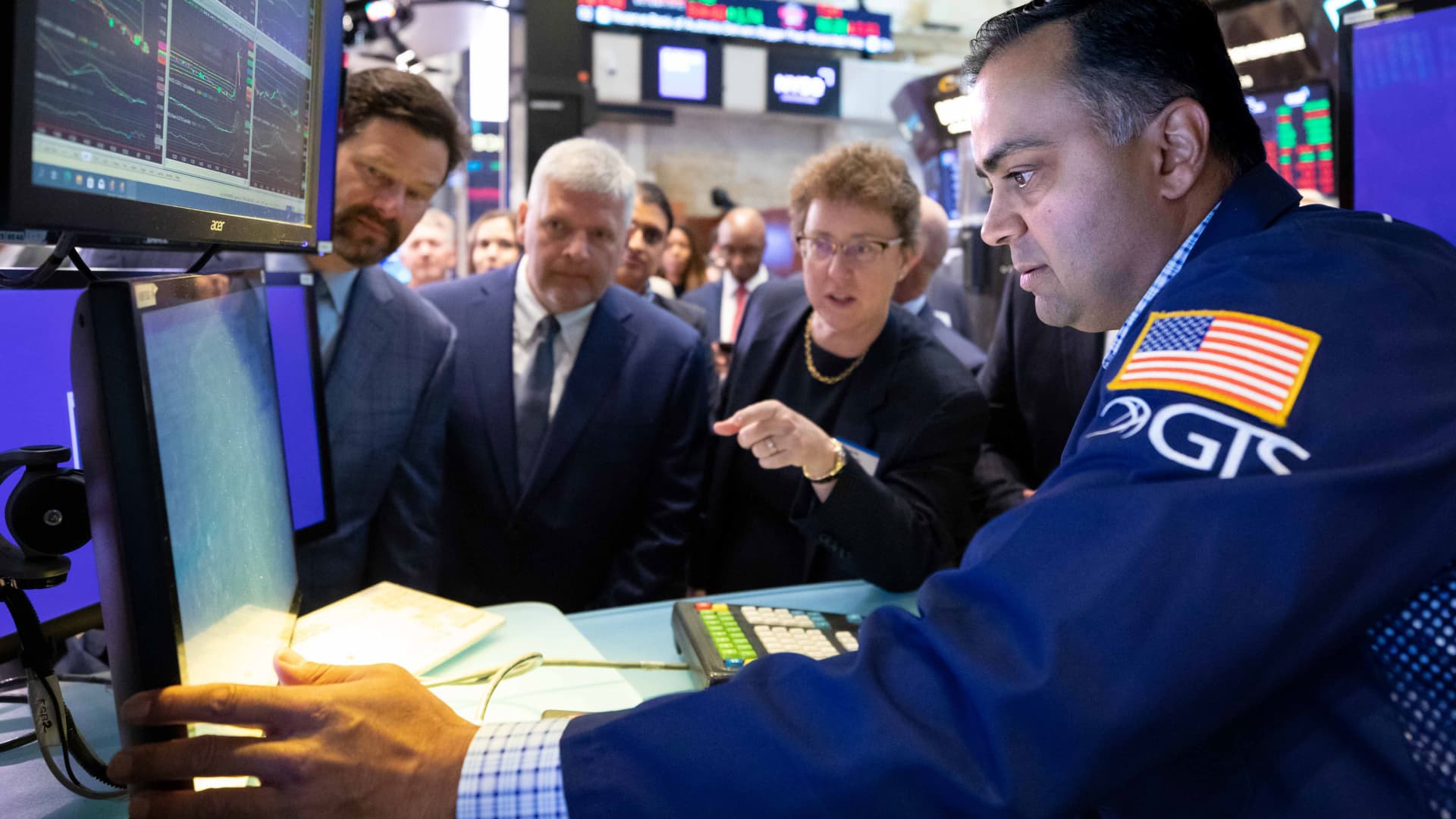Quarter-end buying may lift stocks higher before the next market storm


The stock market is about to close out its worst first half in decades in the week ahead, setting the stage for a summer of uncertainty and volatility.
But in the very near term, strategists see a window of positive momentum for an oversold market and say the end of the quarter could be a time for some quick gains. That period, leading up to the final trading day of the month, is when many portfolio managers shift their investments, or rebalance, to make up for the changes in the values of their stock and bond holdings.
JPMorgan’s Marko Kolanovic, for one, sees a case in which stocks could surge 7% in the week ahead, based on rebalancing alone. With the S&P 500 down more than 13.7% for the second quarter and 17.9% for the year so far, investment managers will have to boost stock holdings to regain asset allocation levels.
“Next week’s rebalance is important since equity markets were down significantly over the past month, quarter and six-month time period,” wrote Kolanovic, the firm’s chief global markets strategist. He emphasized that rebalancing activity is not usually the only driver of markets.
Loading chart…
Recent rebalances have been positive for stocks, and that could mean this one will be as well, he noted. For instance, near the end of the first quarter, the market was down about 10%, and there was a significant 7% rally in the final week heading into quarter end. The same type of move also happened in the smaller May rebalancing, when stocks rallied about 7% going into the month end after a decline of about 10%.
“It is happening in a period of low liquidity. On top of that, the market is in an oversold condition, cash balances are at record levels, and recent market shorting activity reached levels not seen since 2008,” Kolanovic added.
But after a rally, some strategists are already looking ahead to a choppy third quarter.
“Historically, the third quarter, along with the second quarter, are the worst quarters of the 16 quarter presidential cycle,” said Sam Stovall, chief investment strategist at CFRA. “Once the uncertainty associated with mid-term elections has run its course, or once the third quarter has run its course, the fourth quarter as well as the next two quarters are the best of the 16-quarter presidential cycle.”
According to CFRA, the S&P 500 fell an average 0.5% in the third quarter in the second year of a presidential term, after an average 1.9% decline in the second quarter. In the data, going back to World War II, there was an average bounce back of 6.4% in the fourth quarter.
The mid-term elections are in November, and many political strategists expect a shift in power toward the Republicans in Congress.
Stovall said for now, the market could trade higher into the start of the earnings season. “If history repeats itself, from a timing perspective, we get a tradeable bounce now,” he said. But he added that could be followed by a washout later in the quarter, and that could ultimately bring capitulation.
If the second quarter ends near its current level, it would be the worst first half for stocks since 1970. But according to Stovall, a bad first half doesn’t necessarily mean a bad year.
“Of the [previous] five worst since 1929, all five were higher in the second half and gained an average of 23.7%…Of the next five, four of the five are down and the average is a decline of 7.8%,” said Stovall.
Market on holiday
The week ahead of the long Fourth of July weekend looks to be fairly quiet, though there are some key economic reports. Corporations may also disclose some guidance on earnings, particularly if they expect to miss expectations in the coming reporting season.
On the economic front, most important could be Thursday’s personal consumption expenditures data which includes the PCE deflator inflation reading, which is closely watched by the Federal Reserve.
The durable good report is due out Monday. Consumer confidence and S&P/Case-Shiller home price data will be released Tuesday, and ISM Manufacturing Friday.
“My guess is the market is trying to rally right now with bond yields coming down, and equities putting in a few decent sessions,” said Jimmy Chang, chief investment officer at Rockefeller Global Family Office. “It could probably rally into the July 4th holiday, and the real show starts with the earnings season.”
Major banks begin reporting earnings July 14 and 15.
“By the second week of July, we will see what the tone will be with the earnings, and I would expect a much choppier market given my expectations that some of these companies will take down guidance,” said Chang. He said what’s unclear is how much of the anticipated negative news is already priced in, given the market’s already sharp decline.
“Guidance is crucial,” said Quincy Krosby, LPL Financial chief equity strategist. “What the market is trying to decide is whether or not we are headed into a recession and what kind of recession…The corporations in their guidance at this crucial stage are going to tell us whether or not the market is poised for a deeper sell-off.”
Stocks were higher Friday, and bond yields were also recovering from a steep drop off after the prior week’s sharp run up. The benchmark 10-year Treasury yield topped 3.48% on June 14, slid to 3% by Thursday. It was back at 3.13% on Friday. Bond yields move opposite prices.
The S&P 500 closed the week at 3,911, with a 6.4% gain.
Loading chart…
A big source of angst for investors is whether inflation will continue to flare and drive aggressive Fed rate hikes, leading to a possible recession. The bond market this past week was reflecting some of that fear, after the Fed raised rates by 0.75 percentage point in the prior week and looks set to boost the federal funds rate by a similar magnitude in July.
“It’s a narrative in overdrive. You go from inflation fears, and a 75 basis point hike… to only realize the more the Fed hikes, eventually they’re going to tip us into recession. All this in a matter of a week,” said George Goncalves, head of U.S. macro strategy at MUFG.
Week ahead calendar
Monday
8:30 a.m. Durable goods
10:00 a.m. Pending home sales
6:30 p.m. New York Fed President John Williams
Tuesday
Earnings: AeroVironment
8:00 a.m. Richmond Fed President Tom Barkin
8:30 a.m. Advance economic indicators
9:00 a.m. S&P/Case-Shiller home prices
9:00 a.m. FHFA home prices
10:00 a.m. Consumer confidence
12:30 p.m. San Francisco President Mary Daly
Wednesday
Earnings: Bed Bath & Beyond, General Mills, McCormick, Paychex, MillerKnoll
6:30 a.m. Cleveland Fed President Loretta Mester
8:30 a.m. Q1 Real GDP (third reading)
9:00 a.m. Fed Chairman Jerome Powell at European Central Bank forum
1:05 p.m. St. Louis Fed President James Bullard
Thursday
Earnings: Micron, Walgreen Boots Alliance, Constellation Brands, Accolade
8:30 a.m. Initial claims
8:30 a.m. Personal income/spending
9:45 a.m. Chicago PMI
Friday
Vehicle sales
9:45 a.m. S&P Global Manufacturing PMI
10:00 a.m. ISM manufacturing
10:00 a.m. Construction spending
2:00 p.m. Bond market closes early for July 4 holiday
This post has been syndicated from a third-party source. View the original article here.




